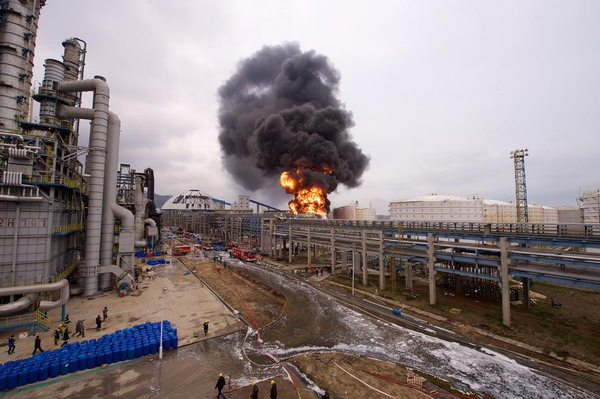|
 |
| A big fire is seen at a chemical plant in the Gulei Peninsula in Zhangzhou, Fujian province, April 8, 2015. [Photo/Xinhua] |
Blast at a manufacturer of paraxylene in Fujian province earlier this month was caused by the poor quality of the chemical plant's equipment and has been determined as an accident due to negligence, said spokesperson of the State Administration of Work Safety at a press conference in Beijing on Wednesday.
The PX plant's people in charge "put benefit before work safety" and chose the bidder that offered the lowest cost of building of the equipment, said Huang Yi, the spokesman, at the press conference held in the State Council Information Office.
According to the investigation's latest findings, the blast was caused by a leak of paraxylene from a crack in the tube due to the poor welding of joints. The boiler came in contact with the flammable material and exploded.
The inappropriate layout of placing boilers too close to storage tanks poured oil over the flames: the exploded boiler's blast wave tore the biggest storage tank nearby, ignited the paraxylene and caused huge fires.
"The blast exposed serious problems in the chemical plant's safety management and local government's supervision," Huang said. "We must severely deal with whoever and whichever department is related to the accident."
The explosion happened in the PX plant of Tenglong Aromatic Hydrocarbon (Zhangzhou) Co Ltd on the Gulei Peninsula in Zhangzhou, Fujian on April 6. The accident injured six and forced a total of 29,096 residents in the surrounding area to evacuate.
It was the second accident in 20 months at the same plant. To prevent more accidents, the State Administration of Work Safety has dispatched four groups to inspect the country's 14 PX producers recently and found they are "all in safe, stable operation", according to Huang.
"The production techniques of paraxylene are advanced. Accidents can be prevented as long as we ensure strict management of the work safety," he said, adding that China's production capacity of paraxylene now meets only half of the country's need for it.
The industrial chemical is used for making fiber and plastics that are closely related to people's daily necessities. Although paraxylene is not high-risk or highly toxic, it is flammable and combustible.
Hazardous chemicals are a focal point of the national work safety supervisor's job, said Yang Yuanyuan, deputy head of the State Administration of Work Safety. He revealed that more than 7,000 parts of the 120,000 kilometers of pipelines that transfer gas and petroleum, both being hazardous chemicals, have safety problems.
"The supervision of the production safety of hazardous chemicals requires professional knowledge and skills. We don't have many experts in this area among the about 100,000 work safety supervision staff nationwide," Yang said.
"To make up for it, we will hire experts to participate in our inspections and enhance the training on our staff."
The State Administration of Work Safety has set the goal of "zero death" in coal mine production, but the flooding accident in a coal mine in Datong, Shanxi province on April 19 has claimed at least 19 miners' life.
"The 'zero death' slogan shows that we put human life in the first place. Protecting people's life is the priority of work safety," said Huang, the national work safety supervisor's spokesman.
"The goal of 'zero death‘ in coal mine production is not out of reach. Last year, 95.4 percent of the 11,000 coal minds in China reached this goal."
There were 42 accidents that each caused 10 deaths or above last year, 13 of which were traffic accidents, according to Yang, deputy head of the State Administration of Work Safety.
He added that 75,000 sections of highways, with a total length of 65,000 kilometers, that have sharp turns, steep slopes or on the edge of waters or cliffs don't have guardrails.
"We have set the goal of building guardrails at these sections by the end of Thirteenth Five-Year Plan (2016-20)," Yang said.
